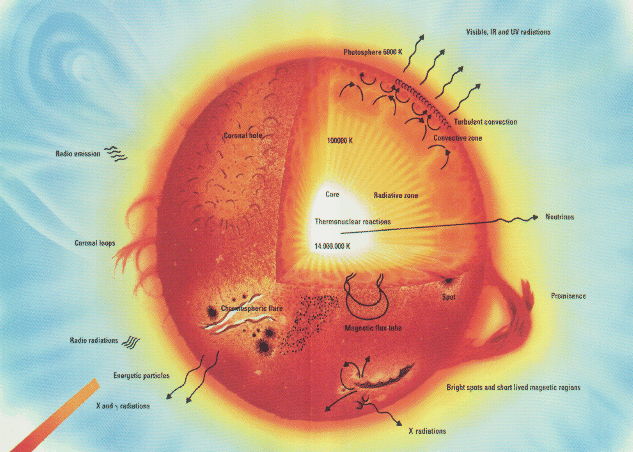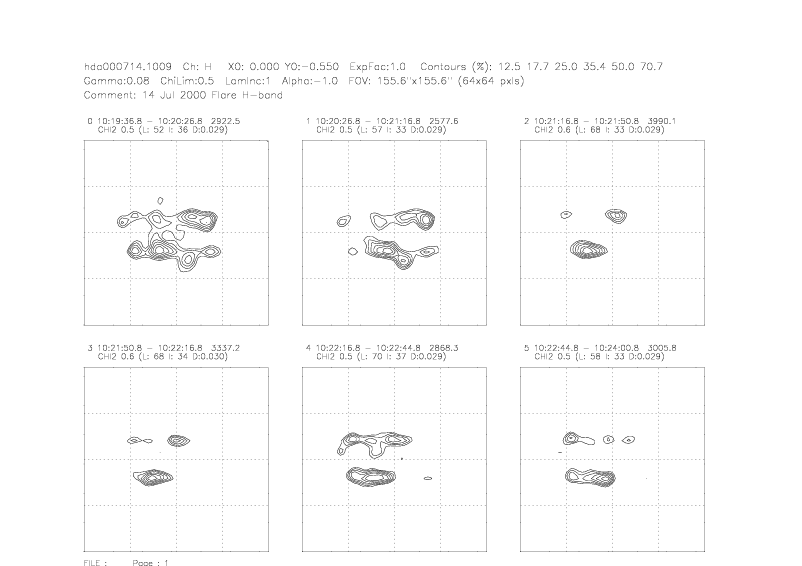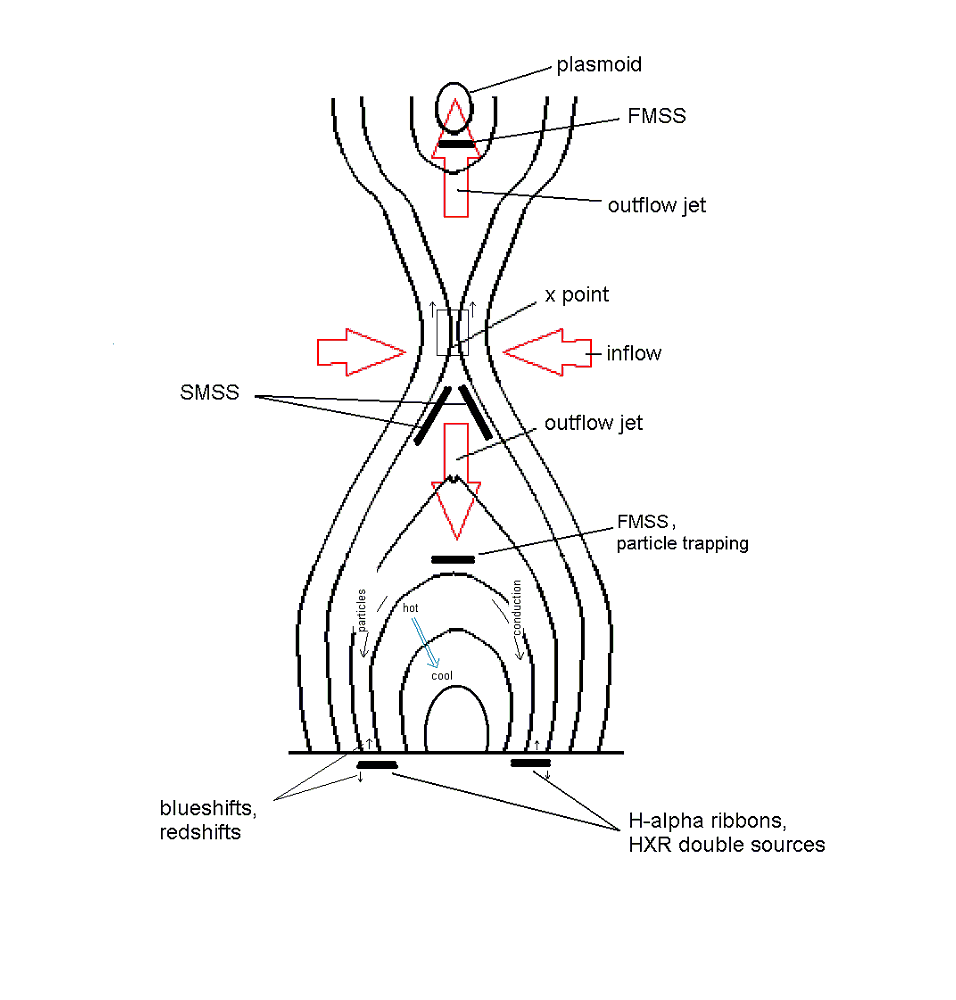

The sun's corona
is a very active part of the sun. The origin of its high temperature
has been questioned for a long time. Earlier theories thought that
the energy came from convection at the solar surface, which caused acoustic
or magnetohydrodynamic shock waves. Another theory is being explored that
the corona is heated by electric currents induced by changing magnetic
fields. Since the corona is always streaming outwards in the form
of a flux of particles, the corona is constantly being replaced with material
from the chromosphere. The corona, therefore, cannot store energy
because it is so diffuse. Solar flares occur in the corona as the
most violent form of solar activity. They are used in the study of
energy from the sun. They are associated with very high temperatures,
around ten million Kelvin, and they cool to chromospheric temperatures,
4500K to 6000K.
Solar flares
are thought to originate from magnetic energy because of the very high
energy output associated with the flares. Solar flares are usually
abrupt releases of energy that come from flux emergence. Long duration
event (LDE) flares are those that last more than one hour, and impulsive
flares are those that are less than one hour. It was found
that flares are best seen in x-rays and EUV rays, which allow the study
of the magnetic properties. By the Zeeman effect, some emission lines
split in the presence of a magnetic field. This shows that not only the
temperature can be obtained, but also a hint at the strength of the magnetic
field. This discovery is the historical basis of Astrophysics.
Solar flares have both hard and soft x-rays by the Neupert effect.
However, LDE flares are characterized by soft x-ray emission and impulsive
flares are more likely to have a hard x-ray spectrum.
If magnetic
fields in the flux tubes are storing the energy for the flares to emerge,
then what are the properties of the magnetic field lines? Magnetic
field lines do not have ends where they are cut off. They are
continuous loops of energy. The magnetic field lines in an
arcade formation are stretched above a magnetic flux tube that becomes
disturbed. The disturbance causes a Coronal Mass ejection, which rises
upward in a flux tube above the field lines and as a result causes the
magnetic field lines to rise upward also where they seem to cut off and
form new field lines. Therefore, magnetic reconnection gives a well
defined model as the answer for the energy released by solar flares.
The Yohkoh satellite has shown that LDE flares show cusp-shaped loop structures
which follow the model for magnetic reconnection. There is
evidence that some have found for magnetic reconnection in LDE flares:
the temperature is higher in outer loops, the cusp-shaped loops seem to
grow with time, the energy release rate along with physical quantities
agree with the magnetic reconnection model, and the plasmoid ejections
are seen in the rise phase of LDE flares (Shibata 1999).
The ionized
particles in the sun serve as good conductors for energy. The magnetic
field, therefore, moves along with the ionized plasma. The resistivity
in this system is much less than one (p<<1); if the length scale
is large, this means that it would take 10 million years for the resistivity
to become large enough to break the close connection with the plasma and
magnetic field lines (t~1/p). If this happened the magnetic field
lines could reconnect if they moved to the outer edge of the plasma.
This, however, seems highly impossible. Other alternative models
for reconnection are that the eccentricity would have to be much greater
than the initial resistivity (e>>p0) or the length scale could be a small
area. The length scale of a small area seems more probable because
the magnetic field could then slip through the plasma. Some evidence
of this has been shown in Yohkoh images and TRACE images. TRACE images
are at a better resolution than Yohkoh images, but a better telescope with
finer resolution has not yet been constructed in order to see better reconnection
details.
The reconnection
model begins with a magnetic flux loop that emerges out of the surface
of the sun. This loop is characterized by a magnetic field, therefore,
the ionized particles that are in the upper chromosphere and corona spiral
around this loop because they are charged. The loop "grows" upward
and the base "feet" are thought to move inward as the energy is stored
and builds up in the loop. The loop grows until it breaks and reconnects.
Then it collapses and comes back down close to its resting position, accelerating
particles in the loop. The particles are accelerating electrons and
protons, which emit gyrosynchroton radiation. At the feet of the
loop where there are dense particles and high pressure, hard x-rays are
produced. Here, particles get heated and they radiate and "evaporate".
Plasma fills the new magnetic loop below the reconnection and it travels
up the loop sides as it evaporates. The upper part of the loop, which
is the part above the reconnection point, cannot be seen because there
is less plasma in that upper region. There is thought to be a "high
speed jet produced by the reconnection which collides with the top of the
reconnected loop to produce a very hot region as well as high energy electrons"
(Shibata 1999).
As the flare
actively erupts and reconnects the magnetic field seems to cascade outward
and upward as subsequent field lines begin to collapse down on one another
after reconnection. There is a gas pressure and a magnetic pressure as
this happens. The reconnected field lines, having been stretched
by the eruption, have magnetic tension and it takes a while for the new
magnetic fields to relax. This shrinking of magnetic field lines
after reconnection and the layers in the reconnection model cause different
temperatures to be present in a solar flare.
Flares are
not two dimensional and therefore can have a third dimension that we cannot
always see or estimate. They can consist of several field lines that
are not visible to us, but behind one another in a ribbon like structure.
These below are a few images of a flare to demonstrate the ribbon like
structure as looking down on a flare from the very top. The flare
stretches from the upper horizontal line (left side of flare) to the lower
horizontal line (right side of flare) in the pictures.

The layers and parts that are in the cusp-shaped loop are the basis of this project. In the center of these solar flares through the peak, it has been discovered that there are different temperatures present at different heights, which follows the reconnection model. Click here to view another source for CSHKP analysis. Below is the diagram of the CSHKP (Carmichael, Sturrock, Hirayama, Kopp, and Pneuman) reconnection model.

Also, in this project the temperature distribution inside the four flares is being analyzed. Specifically the center column that runs through the vertical part of the flare is being looked at. The study of the flares properties will hope to confirm the reconnection model of different layers and temperatures occurring at different times.
Top of Page
Back to Main Page
*Background
Next - Info
My Project
Programs
Results